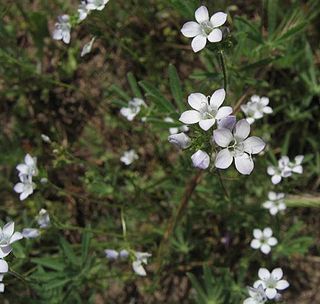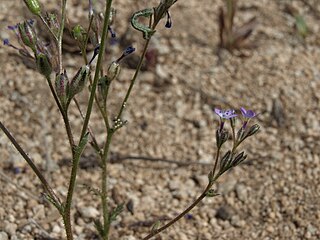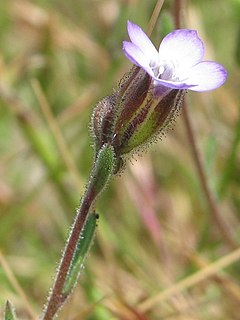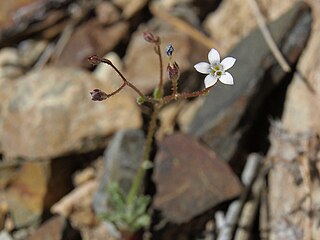
Gilia is a genus of between 25 and 50 species of flowering plants in the Polemoniaceae family and is related to phlox. These Western native plants are best sown in sunny, well-draining soil in the temperate and tropical regions of the Americas, where they occur mainly in desert or semi-desert habitats

Adenocaulon bicolor, the American trailplant, trailplant, pathfinder, or silver-green, is a flowering plant in the aster family (Asteraceae) native to North America. It is found in southern Canada and across the northern and western United States. It is the only species of Adenocaulon native to the United States or Canada. The genus name Adenocaulon is derived from Greek, and refers to the glandular stem. The English name "Pathfinder" was given to this species, because if you walk through a patch of its leaves you will find the path you made through them, with some of the white undersides of the leaves having been exposed, by them having been twisted. Over time, the plant will turn its leaves back with the green side up, and the white side down.

Gilia angelensis is a species of flowering plant in the phlox family known by the common name chaparral gilia. It is native to the coastal hills and mountains of California and Baja California, where it is a member of the chaparral ecosystem., especially in the Transverse Ranges.

Gilia brecciarum is an annual flowering plant in the phlox family (Polemoniaceae), known by the common name Nevada gilia or break gilia.

Gilia capitata is a species of flowering plant in the phlox family known by the common names blue-thimble-flower, bluehead gilia, blue field gilia, and globe gilia.

Gilia latiflora is a species of flowering plant in the phlox family known by the common names hollyleaf gilia and broad-flowered gilia. It is endemic to deserts and mountains of southern California and the adjacent margin of Nevada.

Gilia malior is a species of flowering plant in the phlox family known by the common name scrub gilia. It is native to California and Nevada, where it grows in sandy and rocky soils in the lower and mountain habitats in the Mojave Desert.

Gilia millefoliata is a species of flowering plant in the phlox family known by the common name manyleaf gilia. It is native to the coastline of Oregon and northern California, where it grows in sand dune habitat.
Gilia minor is a species of flowering plant in the phlox family known by the common name little gilia. It is native to the Mojave Desert and it is also present in the coastal Santa Lucia Mountains of central-southern coastal California.
Gilia ophthalmoides is a species of flowering plant in the phlox family known by the common name eyed gilia. It is native to the Southwestern United States where it can be found in woodlands and high desert plateau.

Gilia scopulorum is a species of flowering plant in the phlox family known by the common names rock gilia and Rocky Mountain gilia. It is native to the Mojave and Sonoran Deserts.

Gilia sinuata is a species of flowering plant in the phlox family known by the common names rosy gilia and rosy phlox. It is native to western North America from British Columbia to New Mexico, where it can be found in a number of open habitats, generally in sandy soil, and at elevations from 500 to 7500 feet.

Saltugilia splendens is a species of flowering plant in the phlox family known by the common names splendid woodland-gilia, Grinnell's gilia and splendid gilia.

Gilia clokeyi is a species of flowering plant in the phlox family known by the common name Clokey's gilia. It is native to the south-western United States from California to Colorado, where it grows in desert and other habitat.

Gilia leptantha is a species of flowering plant in the phlox family known by the common name fineflower gilia.

Aliciella leptomeria is a species of flowering plant in the phlox family known by the common names sand gilia and Great Basin gilia. It is native to the Western United States, where it grows in many types of habitat, such as the sagebrush of the Great Basin and in the Mojave Desert.
Gilia salticola is a species of flowering plant in the phlox family known by the common name salt gilia. It is native to the Sierra Nevada and Modoc Plateau of California and western Nevada, where it grows in volcanic and granitic soils.
Aliciella subacaulis is a species of flowering plant in the phlox family known by the common name pinyon gilia. It is native to the western United States from California to Wyoming, where it grows in several types of habitat, such as sagebrush and desert woodlands. This herb produces a glandular stem up to about 30 centimeters tall, surrounded at the base by an erect cluster of lobed leaves each up to 7 centimeters long. There are also smaller, unlobed leaves along the stem. The inflorescence is a loose cluster of purple-washed white flowers with yellow-spotted throats.
Gilia transmontana is a species of flowering plant in the phlox family known by the common name transmontane gilia. It is native to the western United States from California to Utah, where it grows in desert and plateau habitat.
Aliciella triodon is a species of flowering plant in the phlox family known by the common name coyote gilia. It is native to the American desert southwest from California to New Mexico, where it grows in desert habitat such as scrub and woodland. This small herb produces a thin, glandular stem not more than about 13 centimeters tall. The stem is surrounded by a basal rosette of fleshy, sharp-lobed leaves each up to 2 centimeters long. There are sometimes smaller, unlobed leaves on the stem itself. The inflorescence is a solitary flower or loose array of two or three flowers each about 5 to 7 millimeters wide. Each flower has a hair-thin tubular throat opening into a whitish corolla. The corolla lobes each have three distinct teeth.














